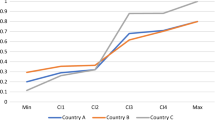Abstract
Using a range of statistical criteria rooted in Information Theory we show that there is little justification for relaxing the equal weights assumption underlying the United Nation’s Human Development Index (HDI) even if the true HDI diverges significantly from this assumption. Put differently, the additional model complexity that unequal weights add to the HDI more than counteracts the improvement in goodness-of-fit. This suggests that, in some cases, there may be limited validity in increasing the complexity of a range of other composite sustainability indices.



Similar content being viewed by others
References
Akaike, H. (1974). A new look at the statistical model identification. IEEE Transactions on Automatic Control, 19, pp. 716–723.
Atkinson, G. (1995). Measuring Sustainable Economic Welfare: A Critique of the UK ISEW. Centre for Social and Economic Research on the Global Environment Working Paper, Norwich and London.
Booysen, F. (2002). An overview and evaluation of composite indices of development. Social Indicators Research, 59, pp. 115–151.
Bossel, H. (1999). Indicators for sustainable development: Theory, method, applications. Manitoba: International Institute for Sustainable Development.
Bozdogan, H. (1990). On the information-based measure of covariance complexity and its application to the evaluation of multivariate linear models. Communications in Statistics, Theory and Methods, 19, pp. 221–278.
Chowdhury, S. and Squire, L. (2006). Setting weights for aggregate indices: an application to the Commitment to Development Index and Human Development Index. Journal of Development Studies, 42, 761–771.
Cobb, C. Halstead, T., & Rowe, J. (1995). The genuine progress indicator: Summary of data and methodology. San Francisco: Redefining Progress.
Daly, H., & Cobb, J. (1989). For the common good. Boston: Beacon Press.
Hardi, P., & Zdan, T. (1997). Assessing sustainable development: Principles in practice. Winnipeg: International Institute for Sustainable Development.
Healy, T., & Côté, S. (2001). The well-being of nations: The role of human and social capital. Paris: Centre for Educational Research and Innovation, Organisation for Economic Co-operation and Development.
Lawn, P. (2006). An assessment of alternative measures of sustainable economic welfare. In P. Lawn (Ed.), Sustainable development indicators in ecological economics, (pp. 139–165). Cheltenham: Edward Elgar.
Lawn, P., & Sanders, R. (1999). Has Australia surpassed its optimal macroeconomic scale: finding out with the aid of “benefit” and “cost” accounts and a sustainable net benefit index. Ecological Economics, 28, 213–229.
Morse, S. (2003). For better or for worse, till the human development index do us part? Ecological Economics, 45, 281–296.
Murray, C. J. L. (1991). Development Data Constraints and the Human Development Index, Discussion Paper, United Nations Research Institute for Social Development, Geneva.
Myung, I. J. (2000). The importance of complexity in model selection. Journal of Mathematical Psychology, 44, 190–204.
Nardo, M. Saisana, M. Saltelli, A., & Tarantola, S. (2005a). Tools for composite indicator building. Ispra: Institute for the Protection and Security of the Citizen, European Commission Directorate-General Research Centre.
Nardo, M. Saisana, M. Saltelli, A., Tarantola, S., Hoffman, A., & Giovannini E. (2005b) Handbook on constructing composite indicators: Methodology and user guide. Paris: Organisation for Economic Co-operation and Development.
Neumayer, E. (1999). The ISEW––not an index of sustainable economic welfare. Social Indicators Research, 48, 77–101.
Pannell, D. J., & Glenn, N. A. (2000). A framework for the economic evaluation and selection of sustainability indicators in agriculture. Ecological Economics, 33, 135–149.
Press, W. H. Teukolsky, S. A. Vetterling, W. T., & Flannery, B. P. (2002). Numerical recipes in C++. Cambridge: Cambridge University Press.
Rissanen, J. (1987). Stochastic complexity and the MDL principle. Econometric Reviews, 8, 85–102.
Sagar, A. D., & Najam, A. (1998). The human development index: a critical review. Ecological Economics, 25, 249–264.
Sagar, A. D., & Najam, A. (1999). Shaping human development: which way next? Third World Quarterly, 20, 743–751.
Schwarz, G. (1978). Investigating the dimension of a model. The Annals of Statistics, 6, 461–464.
Segnestam, L. (2002). Indicators of Environment and Sustainable Development: Theories and Practical Experience. Paper No. 89, Environmental Economic Series, World Bank, Washington DC.
Sneddon, C. S. (2000). ‘Sustainability’ in ecological economics, ecology and livelihoods: a review. Progress in Human Geography, 24, 521–549.
Srinivasan, T. N. (1994). Human development: a new paradigm or reinvention of the wheel? AEA Papers and Proceedings 84, pp. 238–43.
Stapleton, L. M., Laybourn-Parry, J., Poulton, P. R., Tye, A. M., West, H. M., Young, S. D., & Crout, N. M. J. (2006). Parsimonious modelling of nutrient fluxes for a terrestrial ecosystem on Svalbard. Biogeochemistry, 80, 57–69.
Stevens, C. (2005). Measuring sustainable development. Paris: Organisation for Economic Co-operation and Development.
United Nations Conference on Environment and Development. (1992). Agenda 21. New York: United Nations Department of Economic and Social Affairs.
United Nations Development Programme. (1990). Human development report. New York: Oxford University Press.
World Commission on Environment and Development. (1987). Our Common Future. Oxford: Oxford University Press.
Acknowledgements
The authors are working on a European Union Sixth Framework Project (System for Environmental and Agricultural Modelling: Linking European Science and Society; SEAMLESS) which helped provide inspiration for this work.
Author information
Authors and Affiliations
Corresponding author
Rights and permissions
About this article
Cite this article
Stapleton, L.M., Garrod, G.D. Keeping things simple: why the Human Development Index should not diverge from its equal weights assumption. Soc Indic Res 84, 179–188 (2007). https://doi.org/10.1007/s11205-006-9081-3
Received:
Accepted:
Published:
Issue Date:
DOI: https://doi.org/10.1007/s11205-006-9081-3




